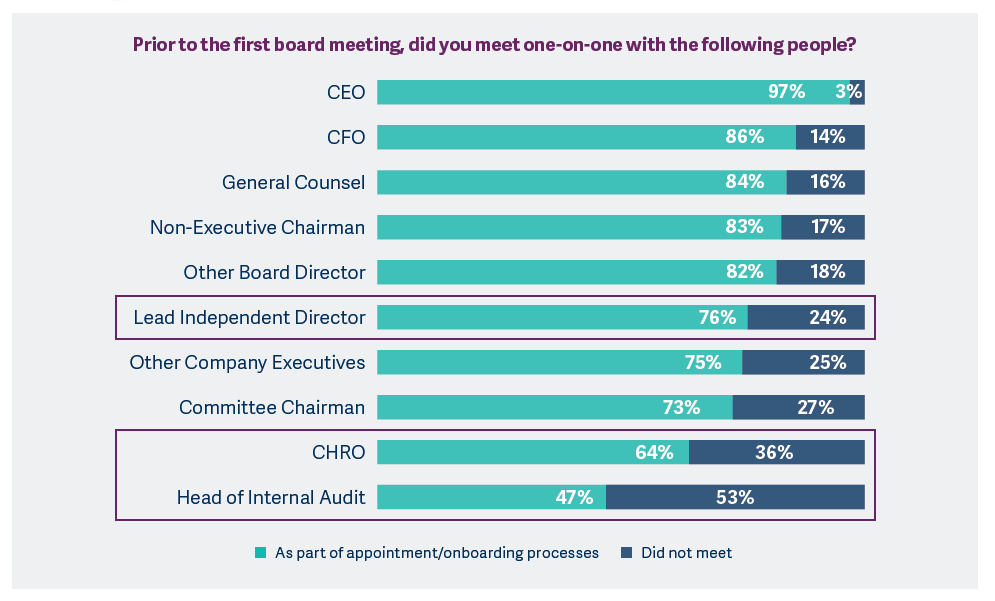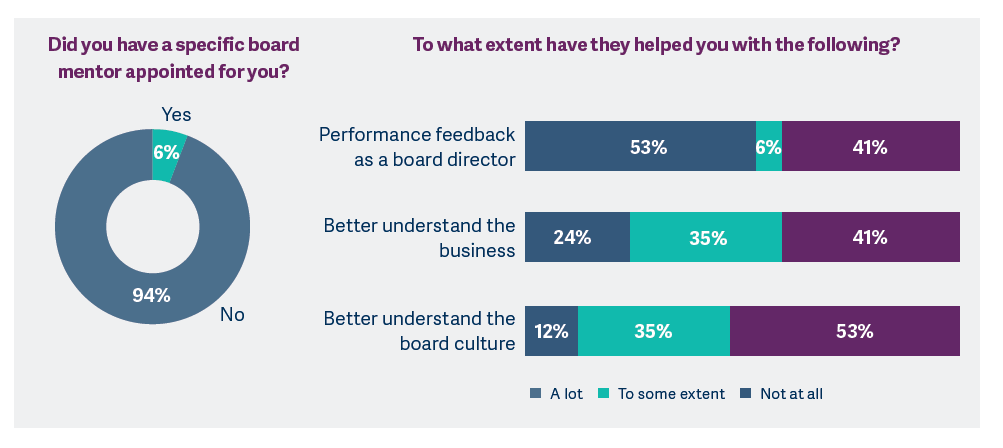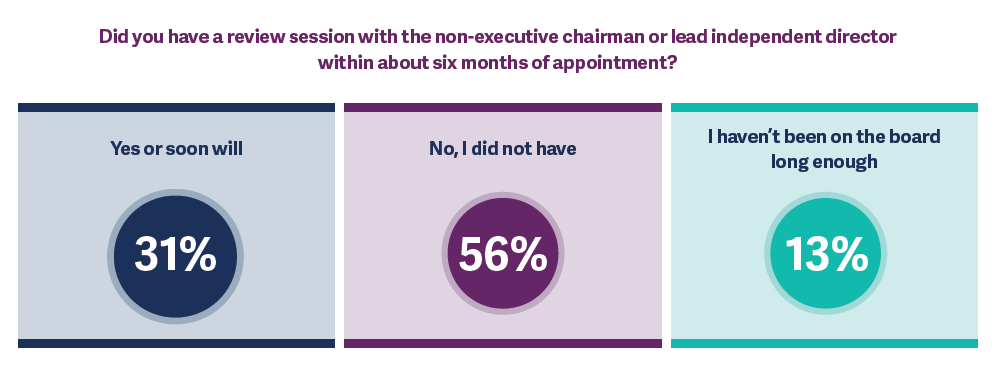Rusty O’Kelley III is the Global Head of the Board Consulting and Effectiveness Practice and Susanne Suhonen is Global Knowledge Leader at Russell Reynolds Associates. This post is based on a Russell Reynolds memorandum by Mr. O’Kelley and Ms. Suhonen.
Boards are increasingly seeking to diversify their membership and draw on expertise from a wider variety of sources. As a result, they find themselves with an exceptional number of new—and often first-time—directors. While the need to acclimate new directors may occur only sporadically, getting it right can be essential to the effectiveness of a board. In a past Russell Reynolds Associates research project, we interviewed new directors based in the UK and learned that it takes them about six board meetings to come up to speed. Given that UK boards typically meet relatively frequently, for US-based companies that translates into more than a year of lost time before new directors are contributing at the level they should.
In response to numerous inquiries from corporate boards about how to effectively integrate new board directors, we launched a research project to learn more about director onboarding practices across Fortune 500 companies. With responses from more than 160 directors representing over 100 Fortune 500 companies, the research shows that many boards are not investing heavily enough in integrating their new members. [1] Few companies tailor their onboarding process, despite the wide range of experiences and tenures new directors bring. Just 24 percent of directors said they had experienced customized onboarding, compared to 58 percent who went through a standardized program.
We believe that boards can increase the effectiveness of new directors by investing in modular onboarding content that they assemble in different ways to meet the varying needs of new members and then deliver over an extended period of time. We also see an opportunity to elevate the onboarding process to more senior levels, with greater involvement from tenured independent directors. As part of the onboarding process, we see board mentoring—along with coordinated welcoming efforts by all directors—as an important means of efficiently integrating new board members.
In this post, we will discuss five key elements that will help companies build successful director onboarding programs.
1. Personalize the process and experience
Many companies have become more intentional about assembling a wide range of perspectives in the boardroom, appointing directors who are seasoned general managers, experienced leaders in adjacent industries and experts in other areas such as digital transformation or international business. One of the most striking findings from our survey was that despite this diversity of backgrounds, most directors—nearly 60 percent of them—received a standardized onboarding process. Fewer than a quarter of new directors had a customized onboarding process and—most surprisingly—almost a fifth had no formal onboarding at all.
The data also showed a lack of consistent onboarding programs for committees. Fewer than half—47 percent—of directors received onboarding for specific committees. Among those who received committee onboarding, about half of the programs were for the audit committee, 30 percent were for the compensation committee and 11 percent were for the nominating and governance committee, with the balance for others.
In our view, boards have an opportunity to accelerate new directors’ performance by investing more heavily in customized onboarding experiences and processes. To enhance director impact, we believe each company should have a standardized core and then create modular add-ons to meet the specific needs of different directors. A first-time director may need a basic introduction to board protocols and norms, for example, while a director from a different industry may need an orientation to sector-specific metrics and jargon. Additionally, the onboarding program should be heavily focused on getting to know all the other board members and all members of senior management, as well as becoming familiar with the business. The onboarding process also can and should include site visits to key facilities, with opportunities to observe operations and meet employees, as well as a current analysis of the competitive landscape. While directors will undoubtedly do their own due diligence before accepting a board position, a robust and thoughtfully designed onboarding program will help them put what they learned into context.
Companies will also want to think about how they pace the orientation. Rather than a one-off event that requires cramming large amounts of information into a short time span, we suggest spreading out the modules over six to nine months to allow the knowledge to grow in context.
2. Create a board-led process
According to our survey, the board secretary is the person most likely to be accountable for onboarding programs, leading the process for 44 percent of new directors. Independent chairs and lead directors rarely have such a prominent role; only 12 percent of new directors cited them as heading up onboarding (only slightly more than the percentage of directors who were responsible for finding their own way).
In our view, effective director onboarding points to reversing these numbers: The independent chair, lead director or chair of the nominating and governance committee should own the onboarding process, with support from the board secretary or other senior executive. Board leaders can provide greater context and nuance around the board culture and strategy. They also can provide an independent view of the company’s situation that may differ from management’s perspective.
And while board leaders face the most intense responsibilities, we see a role for every director to play in integrating new directors. One basic step is for the lead independent director or nominating and governance committee chair to ask each seasoned director to meet up with the new director for a meal or drinks between meetings, looking for any areas of geographic overlap or common interests.
3. Broaden the pool of people new directors meet
We found that a surprising number of directors had not met with key company leaders during either their interview or onboarding process. Nearly a quarter (24 percent) did not meet with the lead director, and 17 percent did not meet the non-executive chairman, depending on the board’s structure, during either their interview or onboarding process. Thirty-six percent had not met the CHRO, and 53 percent had not met with the head of internal audit.
Looking at the interview process alone, these numbers are not exceptional. It is common that a candidate interviewing for a board position would speak with only the board leaders, the CEO and general counsel. However, in the context of the onboarding process, it’s very surprising that a new director would not meet with the lead independent board member. In light of common issues around company culture and financials, we also find it concerning that new board members do not routinely get to know CHROs or internal audit heads.
In line with our other recommendations, we suggest that the onboarding process include opportunities for new directors to meet with all key leaders (at the board and management levels) in the months after joining. These meetings will give the new directors more exposure to company operations and help them better understand what questions to ask in board meetings.
4. Consider a board mentoring program
By nature, most boards of directors are in the same room only eight to 12 days per year. Many fly in and out of town quickly to attend a board meeting, with little downtime outside the meeting itself. Absent a dedicated effort, it can take a long time for board members to build meaningful relationships with each other. When it comes to integrating new directors, then, boards should not rely on such relationships to develop organically but should instead create an intentional, coordinated process for new members to get to know seasoned ones.
We see board mentoring as a growing trend and effective in many cases. Often, a new director is paired with a tenured director, who checks in with the new director regularly during the first 12 to 24 months. The board mentor helps answer questions on everything from historical context and cultural nuances to confusing terms. The mentor also provides feedback about how the new director can improve his or her contribution. And while these formal aspects typically don’t last beyond two years, the informal aspects can endure far longer.
Currently only 6 percent of new directors have a mentor, according to our survey. Among those who have mentors, the most common benefit cited was insight into board culture. We expect this number to grow, albeit slowly, based on what we are hearing from boards.
5. Improve director feedback
There is room to improve on the feedback given to new directors. Anecdotally, we often hear that board members wonder how they are doing and how other directors perceive their progress. This is likely because they do not routinely get direct feedback: More than half of our respondents—56 percent—did not have a review session with the non-executive chair or lead independent director within their first six months.
Providing direct feedback about where the director has added value or can improve his or her knowledge helps accelerate progress along the learning curve. As onboarding meetings are being scheduled for new directors, board leaders should plan for one-on-one review sessions six to 12 months after a director has been appointed.
In conclusion
As boards continue to look for diverse perspectives, we recommend they invest more in their onboarding programs, making them customized, board led and personally welcoming.
Boards can improve the effectiveness of new directors by:
- Creating a board-led process by elevating the onboarding process to more senior levels, with greater involvement from tenured independent directors.
- Considering a board mentoring program along with coordinated welcoming efforts by all directors to effectively integrate new board members.
- Personalizing the process and experience by investing in modular onboarding content that they assemble in different ways to meet the varying needs of new members over an extended period of time.
- Broadening the pool of people new directors meet to include all key leaders at the board and management levels.
- Improving director feedback by scheduling one-on-one review sessions around six to 12 months after a director has been appointed.
A strong onboarding program will pay dividends in the quality of the contributions the board offers the company. It can also help the board to focus its collective thoughts and build stronger relationships. When executed well, a strong onboarding program will ultimately lead to the company creating greater value for its shareholders.
Endnotes
1Russell Reynolds Associates fielded a survey in the spring of 2018 that received responses from 161 new directors, 20 percent of whom were first-timers and 80 percent of whom were experienced directors. Seventy-six percent had board leadership duties.(go back)
2Other includes: CFO and GC; Board committee; CAO; CHRO; Nominating/Governance committee with input from the Board Chair; combination of CEO, Corporate secretary and a board member; General counsel; other members of senior management were responsible for the process; a combination of directors and management.(go back)
 Print
Print




